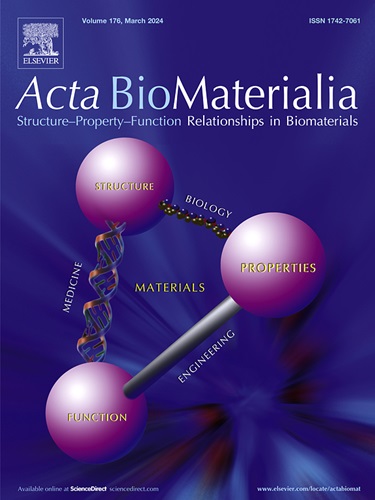Erratic calcareous deposits: Biotic formation insights and biomineralising bacterial strain isolation
IF 9.4
1区 医学
Q1 ENGINEERING, BIOMEDICAL
引用次数: 0
Abstract
The present study investigated the contribution of microbial communities in producing "living stones" and the suitability of these clasts as sources of microorganisms with biomineralisation abilities. The calcareous samples were analysed for their microbial community (16S rRNA gene metabarcoding and culturable approach) and in vitro regeneration tests. Scanning electron microscopy and Energy Dispersive Spectroscopy (SEM-EDX) were applied to investigate microbial aggregation structures and footprints in natural and in vitro samples. The metabarcoding unveiled amplicon sequence variants (ASVs) assigned to lineages with biomineralisation abilities (e.g., Proteobacteria and Actinobacteriota). The culturable approach resulted in nineteen calcifying isolates with diverse morphological, metabolic, and mineral precipitation properties. Based on mineralising properties, Stenotrophomonas maltophilia, Lysinbacillus fusiformis, and Microbacterium ginsengiterrae were identified at the molecular level. In vitro regeneration tests and SEM-EDX analyses confirmed the active role of the endogenous microorganisms in forming these “living stones”. These findings allow us to hypothesise an essential role of microbial precipitation in forming these “living stones”, previously described as of abiotic origin. The current study findings provide a solid scientific foundation for future investigations. The obtained bacterial isolates and their potential applications in bioremediation, construction, and cultural heritage restoration demonstrate the direct applicability of our study in sectors involving biomaterials application.
Statement of significance
We studied some "living stones" that can be found worldwide and whose origin is still not completely understood. Geologists have not yet fully explained the origin of these inorganic structures that grow in size over time. The results obtained from our microbiological investigations allowed us to discover that microorganisms play a crucial role in forming these masses. In the investigations of the structures and microbial communities within the stones, we identified specific bacteria that actively contribute to forming minerals and isolated bacteria that can form biominerals. These findings deepen our understanding of natural processes involved in the formation of these structures and show their potential for several applications (e.g., building materials or cultural heritage preservation).

反常钙质沉积:生物形成见解和生物矿化细菌菌株分离。
本文章由计算机程序翻译,如有差异,请以英文原文为准。
求助全文
约1分钟内获得全文
求助全文
来源期刊

Acta Biomaterialia
工程技术-材料科学:生物材料
CiteScore
16.80
自引率
3.10%
发文量
776
审稿时长
30 days
期刊介绍:
Acta Biomaterialia is a monthly peer-reviewed scientific journal published by Elsevier. The journal was established in January 2005. The editor-in-chief is W.R. Wagner (University of Pittsburgh). The journal covers research in biomaterials science, including the interrelationship of biomaterial structure and function from macroscale to nanoscale. Topical coverage includes biomedical and biocompatible materials.
 求助内容:
求助内容: 应助结果提醒方式:
应助结果提醒方式:


